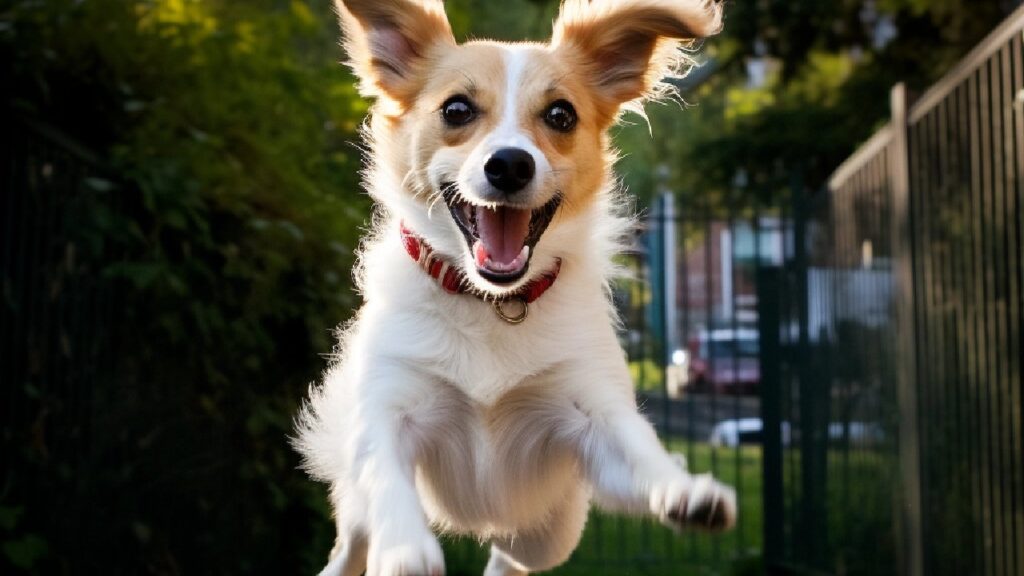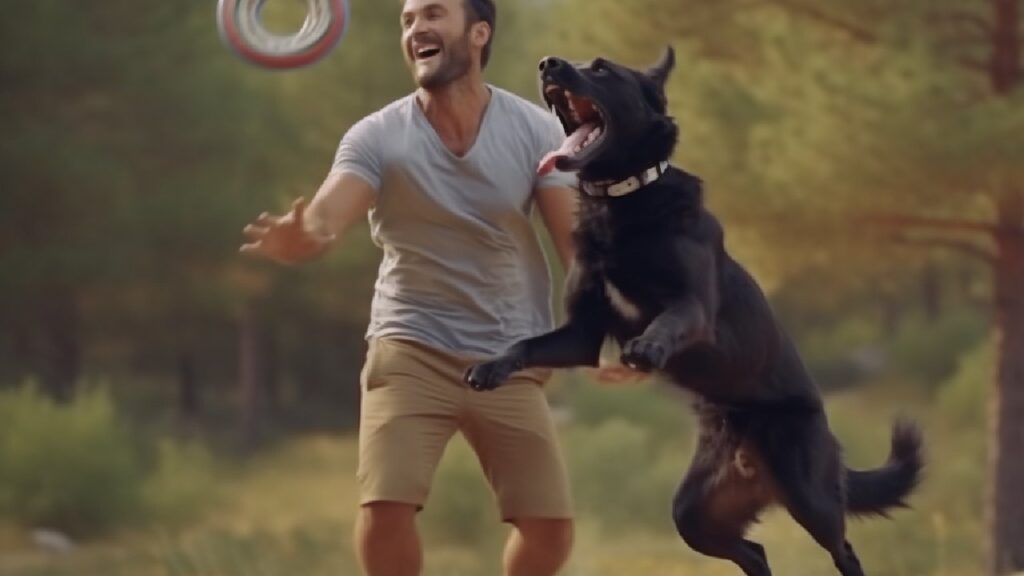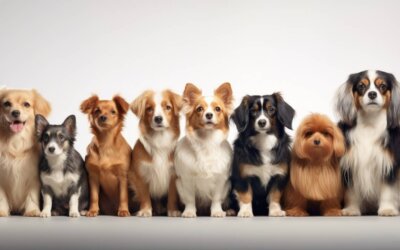The moment you step through the door, you’re greeted with the purest form of love: your dog, tail wagging and eyes shining, bursting with joy. While endearing, this exuberance often translates into an overly enthusiastic habit – jumping up on people. It’s a behavior that’s as common as it is challenging.
This guide explores why dogs jump and offer effective strategies to teach your furry friend more respectful ways to express their happiness. Let’s journey together towards transforming their excitement into calm, affectionate greetings.
Understanding Why Dogs Greet by Jumping
Dogs have an innate need for social interaction, and their greeting reflects their instincts. In the wild, dogs approach one another head-on, engaging in face-to-face interactions to establish a connection and demonstrate submission.
When your dog jumps up on people, they’re attempting to reach your face, a canine way of saying “hello” and seeking a warm embrace.
The Basics of Training to Prevent Jumping
Addressing unwanted jumping behavior in dogs requires a thoughtful and strategic approach.
By implementing these fundamental training techniques, you can teach your dog alternative ways to greet people and curb their exuberant leaps.
- Establishing Ground Rules
To prevent your dog from jumping up on people, the foundation of your training lies in maintaining consistent ground rules for greetings. Everyone who interacts with your dog should be on the same page. When your dog’s paws are on the ground during greetings, they receive attention, treats, and affection.
Conversely, when they jump, the attention is withdrawn, showing them that jumping is not an acceptable way to greet. Consistency is crucial because mixed messages can confuse your dog and hinder their progress in understanding the desired behavior.
- Redirecting Focus
Dogs thrive on routines and patterns. Instead of simply discouraging jumping, give your dog an alternative way to greet people. Teach them commands like “sit” or “shake.” When they associate these commands with greetings, they’ll become more inclined to sit or offer a paw rather than jump.
- Positive Reinforcement
When your dog approaches people calmly and keeps all paws on the ground, instantly reward them with treats, verbal praise, and affectionate strokes.
This creates a positive association between calm behavior and rewards, motivating your dog to replicate this behavior during future interactions. Over time, they’ll learn that maintaining composure leads to enjoyable interactions.
- Ignoring Unwanted Behavior
Dogs love attention, regardless of whether it’s positive or negative. When your dog jumps up on you or others, respond by turning away, crossing your arms, and withholding attention. If necessary, you can even step out of the room briefly.
This approach demonstrates that jumping doesn’t result in the desired outcome, encouraging them to explore more appropriate ways of greeting.
Common Mistakes to Avoid During Training
Recognizing the common mistakes to avoid during dog training is the first step toward creating a more harmonious environment for your dog and stopping unwanted jumping behavior.
- Inconsistent Responses
Consistency is paramount in dog training. If you respond to jumping behavior inconsistently, your dog will become confused about what is expected of them.
For instance, if you allow jumping sometimes and discourage it at other times, your dog won’t be able to differentiate the desired behavior. Ensure that everyone in your household follows the same rules and enforces consistent responses to jumping.
- Negative Reinforcement
Using punishment, scolding, or harsh methods to discourage jumping can have counterproductive effects. Negative reinforcement can create fear and anxiety in your dog, making them associate interactions with you and others with negative experiences.
This can hinder trust-building and overall training progress. Instead, focus on positive reinforcement, rewarding desired behaviors, and redirecting their energy into appropriate actions.
- Inadvertent Rewarding
One common mistake is unintentionally rewarding jumping behavior. If your dog jumps up and you respond with attention, even negative attention, you reinforce the behavior.
Dogs quickly learn that any attention is better than none, which can lead to them continuing the behavior to get a reaction from you.
- Lack of Patience
Training takes time and consistency. Expecting immediate results can lead to frustration on both your part and your dog’s. Every dog learns at their own pace, and progress may be gradual.
Be patient and persistent, and remember that minor improvements should be celebrated as steps in the right direction.
- Ignoring Socialization
Neglecting Socialization can hinder your training efforts. A well-socialized dog will likely remain calm and composed in various social situations, reducing the likelihood of excessive excitement and jumping.

The Impact of Unwanted Dog Jumping Behavior
Unwanted jumping behavior can leave a trail of challenges in its wake. Let’s delve into the impact it can have and why addressing this behavior is about maintaining decorum and ensuring everyone’s safety and comfort.
Discomfort for Individuals
Not everyone finds a dog’s paws on their clothes, body, or face to be a delightful experience. This behavior can be incredibly unsettling for guests with different enthusiasm for exuberant greetings.
Imagine a friend arriving at your doorstep, only to be greeted by an overenthusiastic dog launching themselves onto their outfit. While dog lovers might tolerate this, it can make others uncomfortable, anxious, or hesitant to visit your home.
Safety Risks
Unwanted jumping can pose safety risks, particularly for children, older people, or individuals with limited mobility. A dog’s enthusiastic leap can easily knock over a child or an older adult, leading to potential injuries. Even if your dog’s intentions are pure, their exuberance can inadvertently cause harm.
Reinforcement of Inappropriate Behavior
Allowing your dog to jump on people intermittently or inadvertently rewarding this behavior can reinforce the jumping habit.
Dogs are quick to learn that jumping leads to attention, even if that attention involves scolding or pushing them away. This can create confusion and a lack of consistency in their understanding of what’s acceptable.
Difficulties in Social Situations
The impact of jumping behavior extends beyond your home. In social settings or public spaces, it can lead to discomfort for strangers and fellow dog owners. It can tarnish the positive image of your dog and limit its interactions with other dogs and people.
A Strain on Relationships
While you might understand your dog’s joyful intentions, the same cannot always be said for friends, family members, or strangers. Constant jumping can strain relationships, making social interactions less enjoyable and potentially causing friction between you and those around you.

Final Thoughts on Curbing Your Dog’s Jumping Habit
The journey to stop your dog from jumping on people is fundamentally about fostering a respectful environment and safeguarding the well-being and comfort of everyone involved.
By delving into the root causes of this behavior and applying the right training techniques, you can guide your canine companion towards a more gracious and serene greeting. Remember, it’s never too late to train your dog, and expert advice is always available if needed. Together, you and your dog can master the art of polite welcomes.

FAQs
Will neutering my dog stop the jumping behavior?
Neutering might help reduce certain behaviors, but training remains essential to address jumping effectively.
My dog only jumps on certain people. Why?
Dogs often jump on people they find exciting or those who inadvertently reward the behavior. Ensure everyone follows consistent rules.
Can I discourage jumping through physical barriers like gates?
While barriers can prevent immediate jumping, they don’t address the behavior’s root cause. Training remains crucial for long-term success.
Is it too late to train an older dog not to jump?
It’s always possible to train a dog. While it might take longer, consistent training can lead to behavioral improvements.
Can jumping be a sign of health problems?
Jumping behavior is usually behavioral, but if it’s sudden and extreme, consult a vet to rule out any physical discomfort.
What if my dog continues jumping despite all efforts?
Persistence is key. If challenges persist, consider seeking guidance from a professional dog trainer to tailor techniques to your dog’s needs.






Jumping is a nightmare with my hyperactive pup. Definitely trying these tips out